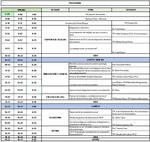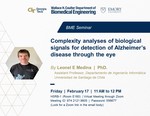ANID Exploración 13220082: Looking through the window: A novel complexity-based electroretinogram analysis for neurodegenerative disease diagnosis
Neurodegenerative diseases (NDs) are one of our most significant public health challenges. In these diseases, neurons in specific brain areas progressively and irreversibly deteriorate until they die. Alzheimer’s disease (AD) and Parkinson’s disease (PD) are two of the major NDs and among the leading causes of death in the elderly population. For NDs, early detection is fundamental because therapeutic interventions can be more successful if initiated at pre-clinical stages before neuronal loss. However, early and accurate diagnosis remains challenging because of the lack of noninvasive and inexpensive reliable diagnostic tests. Moreover, NDs often share pathological and clinical features, making it difficult to differentiate between diseases, especially in early stages. The retina, i.e., where light is converted to nerve impulses, has long been considered a window into the brain. Not surprisingly, there has been great interest in understanding common eye-brain pathophysiological mechanisms and finding potential eye biomarkers for brain disorders. Retinal morphology and function appear to be affected in AD and PD patients, and the critical pathological molecules of AD and PD have been detected in patients’ retinas postmortem. Collectively, these findings show great promise in the search of biomarkers for NDs in the retina. Functional changes in the retina can be detected using the electroretinogram (ERG), in which electrodes placed on the cornea or the skin beneath the eye are used to record the bio-electrical activity of the retina. Recent research has revealed alterations in some ERG characteristics of AD patients, opening the door for further investigation using innovative signal analysis approaches. We recently showed that complexity-based metrics can be used to detect AD in the retina of animals, bringing up new opportunities for the investigation of potential retinal biomarker of NDs. To translate these findings into clinical benefits, in this work we will introduce a new paradigm for ND diagnosis based on 1) a noninvasive ERG device and 2) mathematical tools from complexity theory. Here, complexity refers to the nonlinear interactions and collective behavior of different structural units acting at diverse temporal and spatial scales. Our approach is inspired by the theory of complexity-loss, which postulates that biological complexity decays with aging and disease, an idea supported by mounting evidence in various physiological systems.







